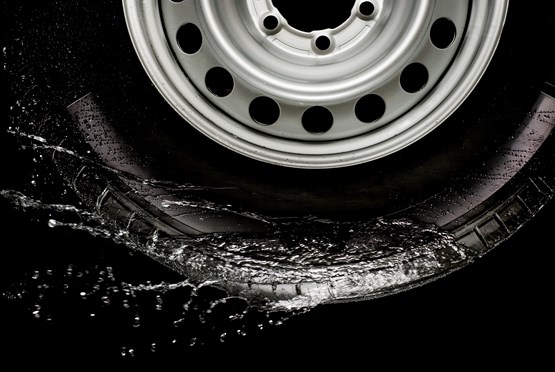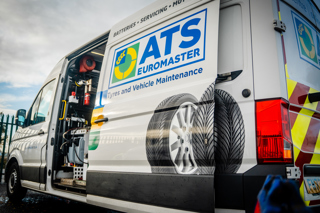 Advances in technology mean that, from a safety point of view, modern vehicles are almost unrecognisable from their forebears.
Advances in technology mean that, from a safety point of view, modern vehicles are almost unrecognisable from their forebears.
Where retractable seatbelts were once the height of safety technology, new cars and vans often have collision-avoidance systems such as autonomous emergency braking and blind spot indicators.
However, one aspect which has stayed the same is that tyres remain the only point of contact a vehicle has with the road, giving them a crucial role in road safety.
“Defective tyres dramatically reduce the effectiveness of a vehicle’s steering and braking systems, can potentially suffer catastrophic deflations and potentially add to the numbers of road casualties,” says Stuart Jackson, chairman of Tyresafe.
This is highlighted by Department for Transport (DfT) figures which show that, of the 48 people killed in road accidents attributable to vehicle defects last year, 58% (28) were due to defective tyres.
The DfT also reported that, out of the 2,855 casualties caused by defective vehicles, dangerous tyres were cited as a contributory factor in 968 cases.
“With this year’s casualty figures from the DfT being comparable to the five-year average, Tyresafe’s main concern is the slow pace at which drivers are taking this message on board,” adds Jackson.
Drivers are, says Phil Clifford, fleet and technical manager at Forest Health District Council and St Edmundsbury Borough Council, “the first line of defence” when it comes to looking after tyres.
However, lifestyle and technology changes mean that they are now less likely to regularly check their tyres than they were five or 10 years ago, says Andy Fern, national sales manager for fleet at Michelin.
“The days of people washing their own cars – traditionally when they checked and pumped up their tyres – have almost gone, so when do they check their own tyres now?” he asks.
“I think there is now a mentality that you go to your car in the morning and you turn the key or press the start button and, unless you see some warning lights on your dashboard, you just drive away.
"There’s almost an expectation that, if something is wrong, the car will tell you.”
Fern says technology such as tyre pressure monitoring systems (TPMS) and run-flat tyres may add to the complacency some drivers feel over tyres.
TPMS systems are a legal requirement for all new-type vehicles built after November 2012 and continuously monitor the pressures of tyres. They alert drivers if the readings fall outside parameters set by the vehicle’s manufacturer.
“We talk to some fleets or leasing companies and they say sometimes they have a challenge to even get their drivers to book their car into a service, so it is difficult to persuade them to react to a tyre pressure warning light,” says Fern.
Drivers should not ignore the TPMS warning light, says Mike Williams, head of national accounts at ATS Euromaster. “At the earliest opportunity, find a safe place to stop where you can manually check your tyre pressures against the vehicle manufacturer’s recommended settings,” he says.
“If you are unable to check your pressures yourself, either call for roadside assistance or locate your nearest tyre professional who will be able to help you.”
Tyresafe recommends tyre pressures should be checked at least every two weeks and only when the tyre is cold, since there is an increase in pressure when it has warmed up after being run. Michelin advises drivers to also check tyre pressures before long journeys.
The best way to ensure tyres are in good condition is through regular – ideally daily – checks, says Peter Lambert, fleet director at Kwik Fit Fleet. “You can’t take chances, because a tyre is the most important safety feature on a vehicle,” he says. “When checking for faults and damage, there is no better way than a visual check.”
In terms of best practice when carrying out such a check, Chris Smith, head of truck marketing at Michelin, says: “Routine is the best way to deal with it. Every time, start with the driver’s door corner, and then work clockwise – check tread, inflation and valves. Regular checks should also look for cuts and bulges in the tyre sidewall."
While tread depth checks are traditionally carried out with a tyre gauge, Sigmavision has launched a handheld scanner, called TreadReader, which produces a colour-coded image.
The device, which is held against the tyre, captures more than 40,000 data points to produce images, which together with a date and time stamp, job number and vehicle registration, are displayed on a connected smartphone or tablet.
The manufacturer says its device eliminates the risk of operator error and inaccurate readings associated with manual depth gauges, and ensures an accurate scan even on wet and dirty tyres.
For recording the checks and reporting faults, Lambert believes the best way of carrying this out is to use handheld technology. “It’s important to give drivers the mechanisms to feed these issues back,” he says. “The relevant information should be kept so, should there be an accident, a copy can be shown to the DVSA or the police, if required.”
Housing Association L&Q Group uses FleetCheck, which requires drivers to carry out vehicle checks, including tyre tread depth, every two weeks through their smartphones.
This sends the data directly to the organisation’s fleet management software package.
“This gives us a record that a vehicle has been checked and is roadworthy,” says fleet manager Maurice Elford.
Incorrectly inflated tyres, whether under or over, have a detrimental effect on performance, says Jamie McWhir, car, van and 4x4 technical manager for Michelin.
“It’s crucial that motorists understand the importance of driving on tyres with the correct pressure, especially as they’re the only point of contact with the road and are therefore critical to the safety of the vehicle, its passengers, other road users and pedestrians,” he says.
Under-inflated tyres cause excessive flexing within the structure of a tyre, meaning the contact with the road is concentrated on the edges of the tread.
It also causes deterioration of the casing and rapid wear of the tread shoulders. Under-inflation also reduces the vehicle’s fuel economy, road-holding, braking, steering and resistance to aquaplaning.
Over-inflated tyres bring their own problems. They concentrate the contact with the road in the centre of the tread, leading to accelerated wear in that area. They also result in an uncomfortable ride and make the tyre more susceptible to impact damage.
Education can help ensure that tyres are correctly inflated.Michelin has worked with Anglian Water over the past five years to ensure tyres are maintained at the correct pressure across the utilities company’s 4,000 employees’ vehicles.
When the project started, a sample of nearly 100 cars and vans, that were inspected by Michelin, found tyres were under-inflated by an average 15.2%. This year, the average pressures were accurate to within 0.1% of the manufacturers’ recommendations.
The programme featured the delivery of a training module for use by managers at all levels to educate staff about the impact different pressures have on the environment, fuel efficiency and tyre life. Michelin also provided tyre inflation posters for Anglian Water to display in its offices and workshops, as well as content for its intranet.
“The beauty of this project is that it can be repeated with any fleet – there’s no investment on its part required,” says Fern.
“It’s about changing attitudes to tyre care for the long-term; we’d be willing to support more customers in achieving these results.”
A growing number of fleets are also using the police or fire services to deliver safety messages to their staff.
Peter Shields, assistant road safety officer for Cheshire Fire and Rescue Service (CFRS), says, like many other emergency service organisations, CFRS goes into companies to deliver road safety presentations, which can cover areas such as tyre pressures and tread depth.
“We have seen an increase in the number of companies asking us to go in and deliver road safety presentations to them,” he says. “Because we are a public service we don’t charge for this.”
The increased tread wear caused by under- or over-inflating tyres also has an impact on grip levels.
Tyre treads are designed to give good grip on wet roads but, in general, wet grip decreases as the tread pattern wears down or as the depth of water increases.
The legal minimum tread depth in the UK is 1.6mm throughout a continuous band comprising the central three-quarters of the breadth of tread and round the entire outer circumference of the tyre.
However, tyre wet grip deteriorates more rapidly in the second half of its tread life and wet stopping distances can dramatically lengthen.
Research by the British Rubber Manufacturers Association found that a car travelling at 50mph fitted with tyres with a tread depth on 4.1mm stopped in 24.3m on a wet road; with 1.6mm, the braking distance increased to 32.7m.
It is therefore advisable that consideration is given to replacing tyres well before they reach the legal minimum: the Royal Society for the Prevention of Accidents recommends that tyres are changed when tread is 3mm.
As well as indicating potential under- or over-inflation, uneven tread wear could highlight that a vehicle’s wheels need to be balanced or are out of alignment.
“When the balancing or alignment is out, drivers will feel a vibration through the steering wheel,” says Lambert.
“This needs to be investigated as soon as possible.”
Some tyre suppliers will check the balancing and alignment of a vehicle free of charge, even if they are not able to rectify the problem.
Michelin and Continental both offer this free service to their customers.
Why choosing the right tyre is important
While the condition of tyres is critical in ensuring a driver’s safety, choosing the correct tyre also has a significant impact.
This has become a simpler decision for fleet operators following the introduction of the tyre labelling scheme in 2012, says Andy Fern, national sales manager for fleet at Michelin.
This focuses on three areas: rolling resistance, external noise and – more importantly for safety – wet braking. “Tyre labelling was a game-changer because it was the first time you saw grading of a given characteristic of a tyre,” says Fern.
“It provides a very visible sign for those three areas, so it has naturally driven tyre manufacturers to look at the likes of wet braking more than they did in the past.”
Fern says choosing the right tyre to suit the weather conditions can also have a positive effect on safety.
At temperatures below 7C, braking distances of winter tyres in the wet are typically 10% less than standard tyres, while in icy conditions, braking distances are reduced by as much as 20%. However, the UK’s unpredictable climate, together with practical and cost issues surrounding changing and storing the tyres, mean the uptake of winter tyres is generally low.
“We had a big interest in winter tyres around three or four years ago when there was almost an entire month below freezing, but that was the year we didn’t have enough of them in the country,” says Fern.
“We made sure we were ready for similar demand the following winter when we were all ready but the weather was much milder. You couldn’t win, you were just waiting to see what the weather would do.”
This unpredictable winter weather helped persuade Michelin to launch CrossClimate this year, the first standard tyre which has obtained Three Peak Mountain Snow Flake (3PMSF) approval, meaning it offers the improved grip of winter tyres but can be used all year round.
Fern says initial take-up of the tyre has been “very strong in certain areas”, with British Gas deciding to fit Michelin CrossClimate tyres to its 13,000 commercial vehicles.
Other manufacturers also offer their own all-season tyres. “All-season tyres are becoming more popular as we see changing climates across Europe,” says Nick Harley, managing director original equipment consumer EMEA at Goodyear.
His company’s Vector 4Seasons Gen-2 is now available as an OE fitment on new versions of the Ford Focus, C-Max, Galaxy and S-Max, as well as the current Fiesta.





















Login to comment
Comments
No comments have been made yet.